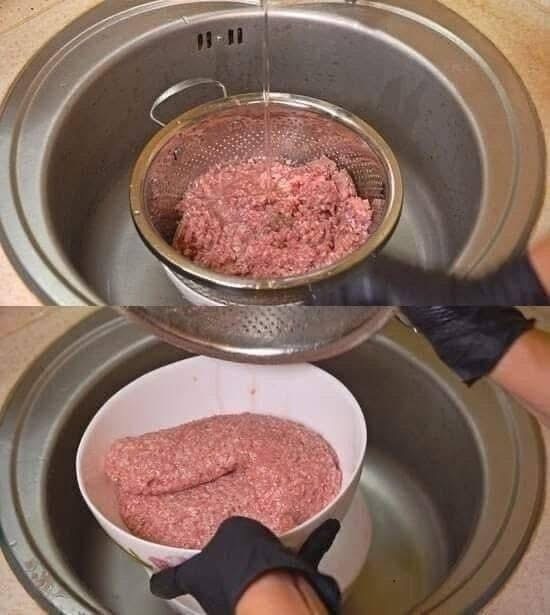Is It Necessary to Wash Ground Beef Before Cooking?
Introduction
When preparing ground beef, many home cooks wonder whether it’s necessary—or even safe—to wash the meat before cooking. The instinct to wash raw ingredients often stems from a desire to remove dirt or bacteria. However, when it comes to raw meat, particularly ground beef, the practice can actually do more harm than good. This article explores the origins of this habit, its cultural significance, food safety science, and best practices for preparing ground beef safely and deliciously.
Origin and Cultural Significance
The tradition of washing meat before cooking originates from older culinary customs and cultural food safety beliefs. In many parts of the world, washing whole cuts of meat, poultry, or fish was a way to remove visible dirt or blood, especially when food sourcing was less regulated.
In modern contexts—especially in regions with strict food safety standards like the U.S., Canada, and the U.K.—the necessity of washing raw meat has diminished due to improved hygiene in meat processing. However, cultural habits persist, passed down through generations as acts of care and cleanliness. Understanding this heritage is key to addressing modern food safety with respect and education.
Ingredients (for Safe Ground Beef Preparation)
| Ingredient | Quantity | Purpose |
|---|---|---|
| Ground beef (lean or regular) | 1 pound (450g) | Main protein source |
| Olive oil or butter | 1 tbsp (optional) | Adds flavor and prevents sticking |
| Salt | ½ tsp | Enhances taste |
| Black pepper | ¼ tsp | Adds depth |
| Garlic or onion (optional) | 1–2 cloves / ½ cup chopped | Flavor enhancers |
Optional Additions
- Spices: Paprika, cumin, chili powder for extra flavor.
- Fresh herbs: Parsley, thyme, or cilantro for freshness.
- Vegetables: Diced bell peppers, mushrooms, or tomatoes can be added during cooking.
- Healthy swaps: Use lean (90%+) ground beef to reduce fat intake.
Tips for Success
- Do NOT wash ground beef. Washing does not remove bacteria; instead, it spreads them through water droplets in your sink and kitchen.
- Cook thoroughly. Heat to an internal temperature of 160°F (71°C) to ensure all harmful bacteria are destroyed.
- Handle with care. Keep raw beef separate from ready-to-eat foods to prevent cross-contamination.
- Use clean utensils. Always wash hands, cutting boards, and utensils after contact with raw beef.
- Store properly. Refrigerate within 2 hours of purchase and use within 1–2 days or freeze for longer storage.
Instructions for Cooking Ground Beef
- Preheat your pan: Heat a skillet over medium-high heat.
- Add oil (if desired): Helps prevent sticking and enhances flavor.
- Add the ground beef: Break it up with a spatula.
- Cook until browned: Stir occasionally until no pink remains—about 7–10 minutes.
- Drain excess fat: For leaner dishes, remove rendered fat using a spoon or strainer.
- Season and serve: Add salt, pepper, and any desired spices or vegetables.
Description
Cooked ground beef is flavorful, juicy, and versatile. It serves as the foundation for numerous dishes—from tacos and pasta sauces to burgers and casseroles. When prepared correctly, it’s both safe and satisfying. Washing is unnecessary because proper cooking temperature eliminates any harmful bacteria effectively.
Nutritional Information (per 3 oz / 85 g cooked lean ground beef)
| Nutrient | Amount |
|---|---|
| Calories | ~180 |
| Protein | 22 g |
| Fat | 9 g |
| Saturated Fat | 3.5 g |
| Iron | 2.1 mg |
| Zinc | 4.5 mg |
| Vitamin B12 | 2.3 µg |
Values vary depending on fat content and preparation method.
Conclusion
Washing ground beef before cooking is not necessary—and can be risky. Modern food safety science shows that cooking meat to the proper temperature is the only reliable way to kill bacteria such as E. coli or Salmonella. Instead of washing, focus on careful handling, thorough cooking, and maintaining a clean kitchen environment.
Recommendation
Always skip the wash and let heat do the sanitizing. If you’re concerned about freshness, purchase meat from reputable sources, check expiration dates, and store it properly. Following safe handling practices ensures both flavor and health.
Embracing Healthful Indulgence
Eating ground beef can be part of a balanced, health-conscious diet when enjoyed in moderation and paired with nutrient-rich sides like vegetables, whole grains, or legumes. By respecting both tradition and science, you can embrace the pleasure of hearty, comforting meals—without compromising your safety or well-being.
